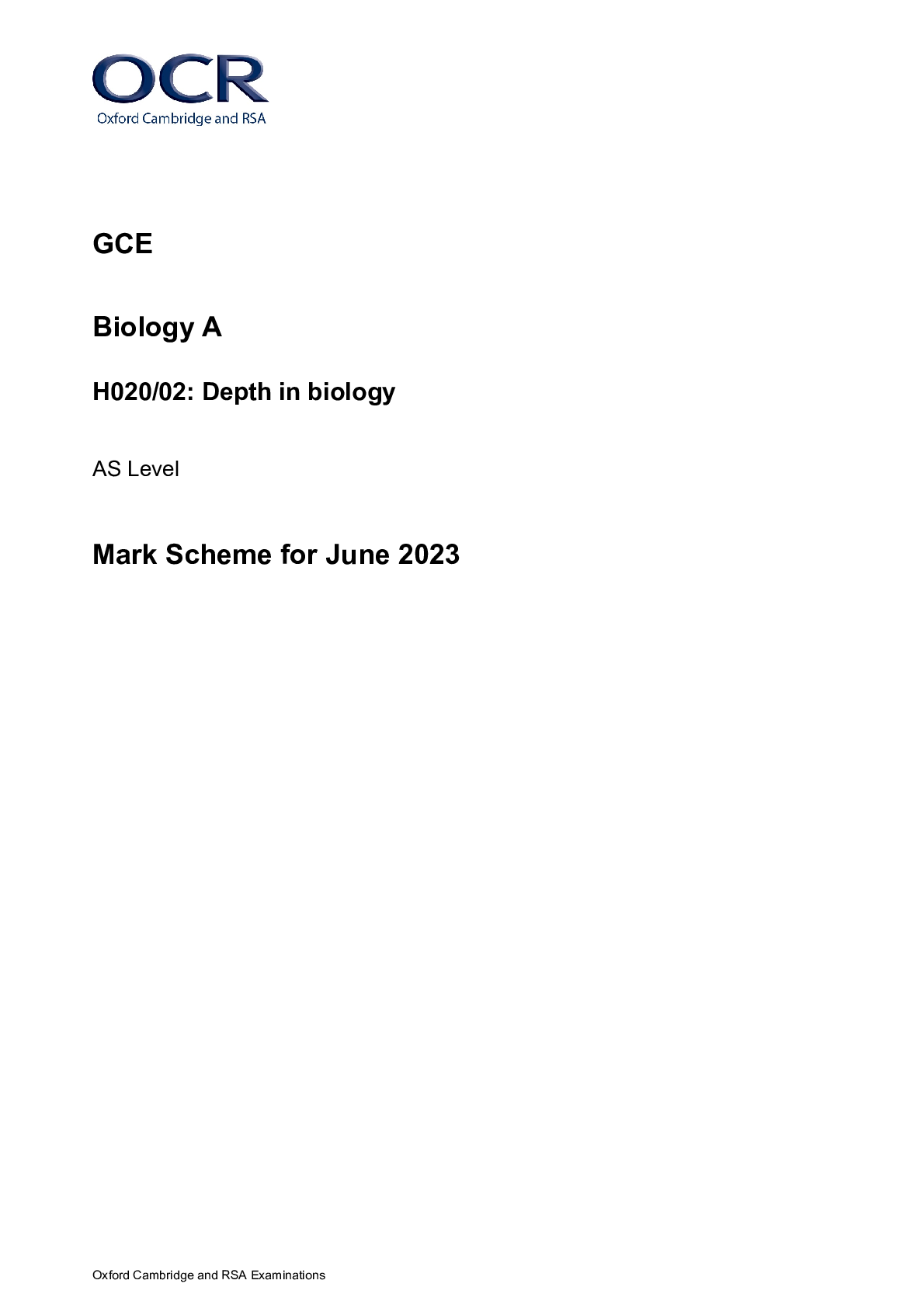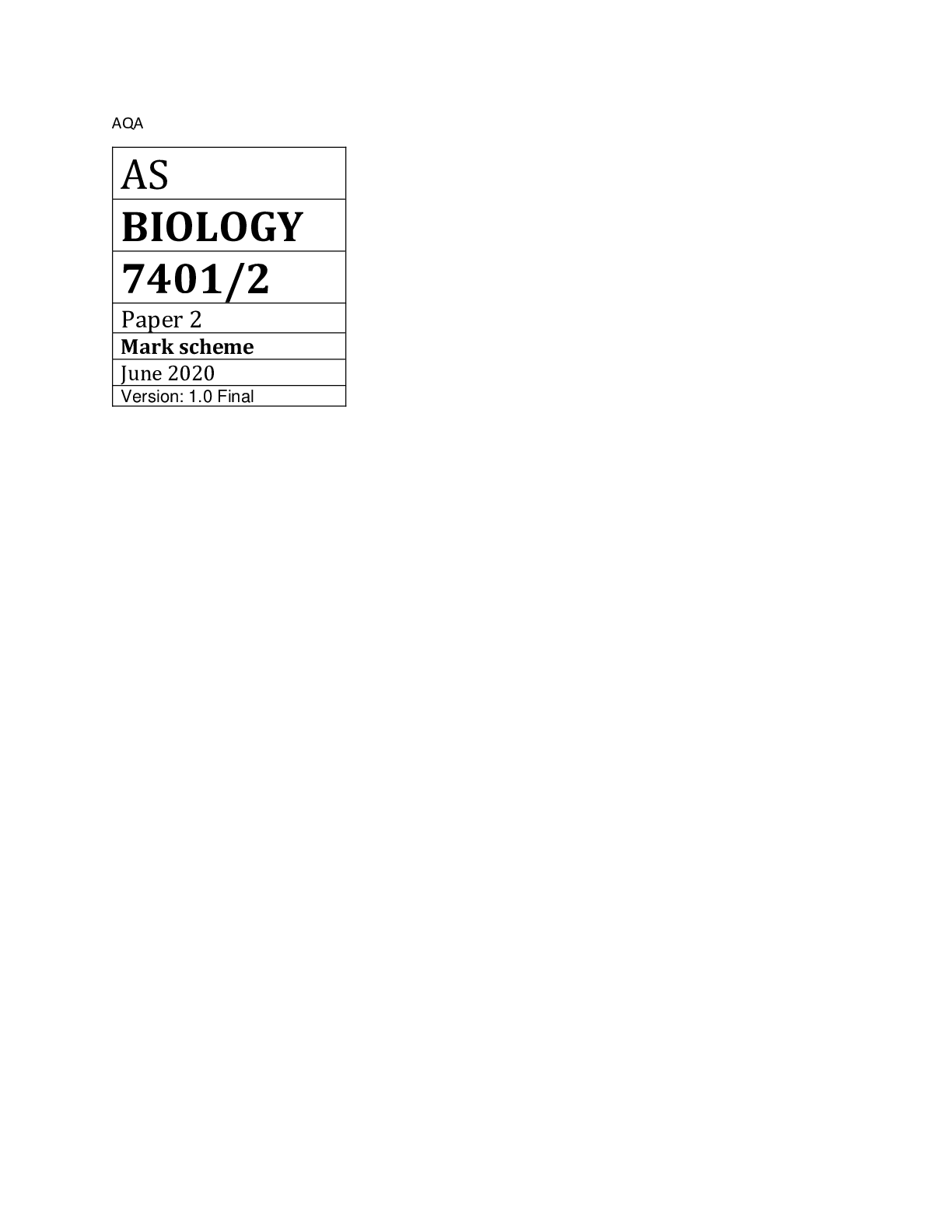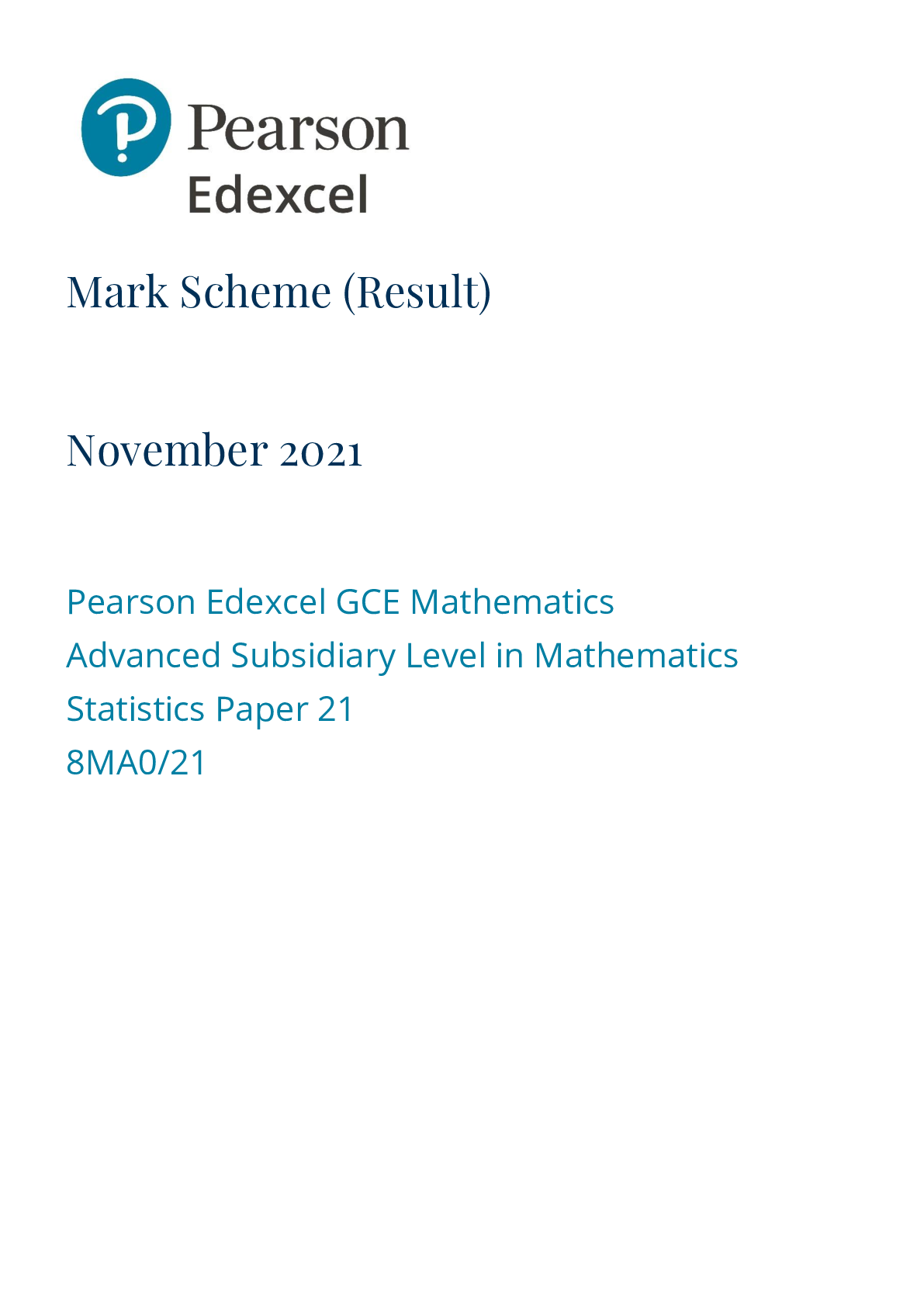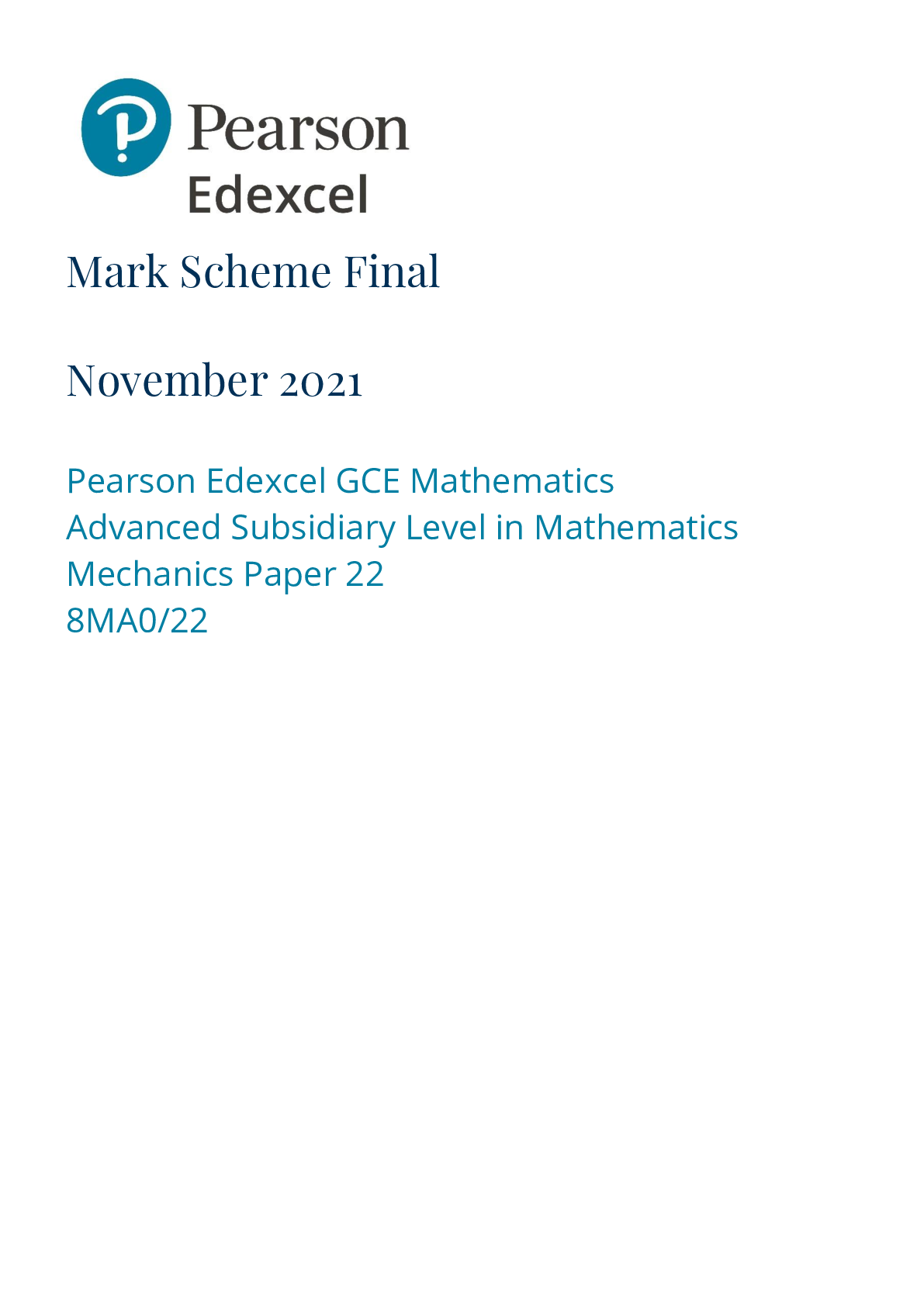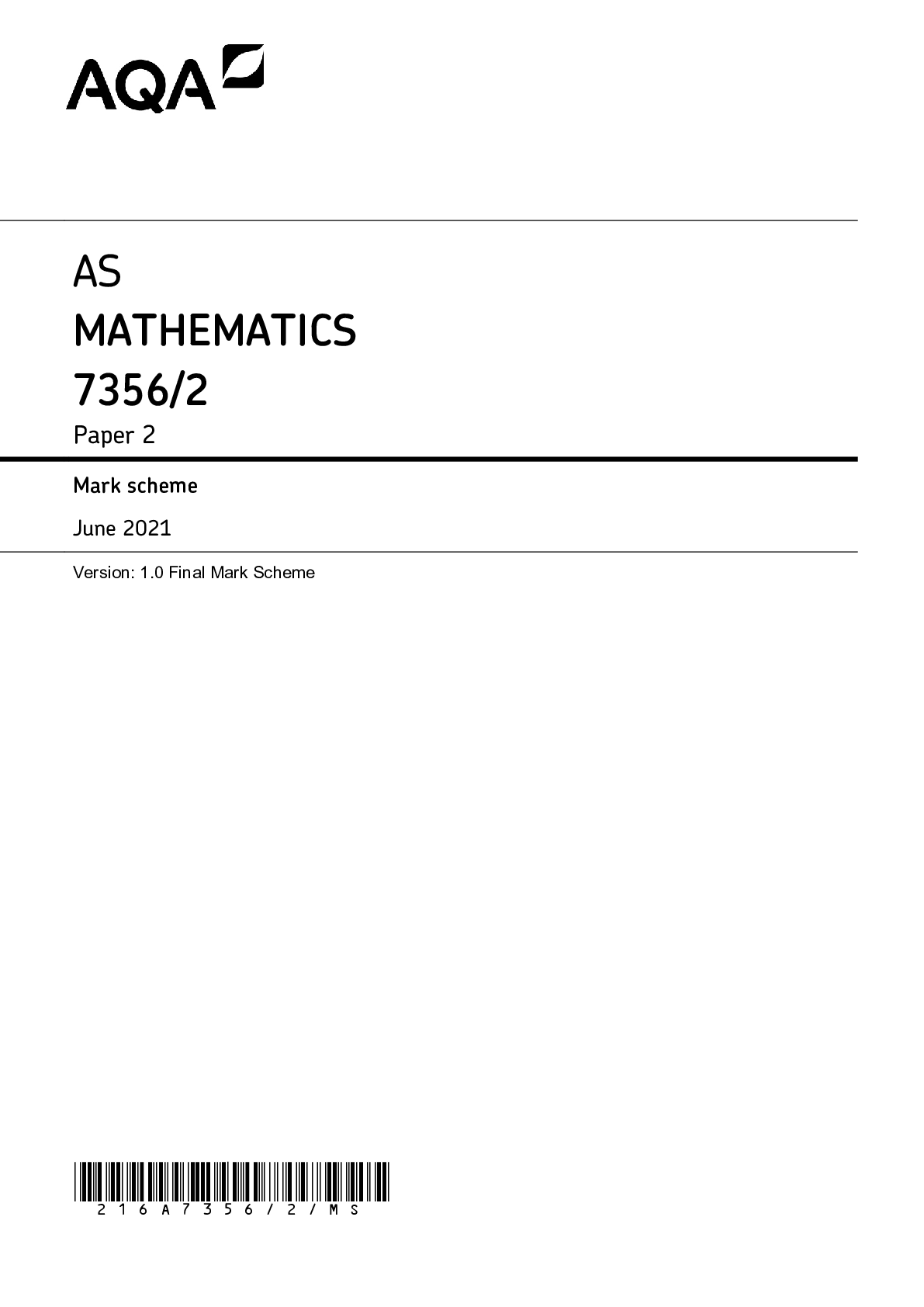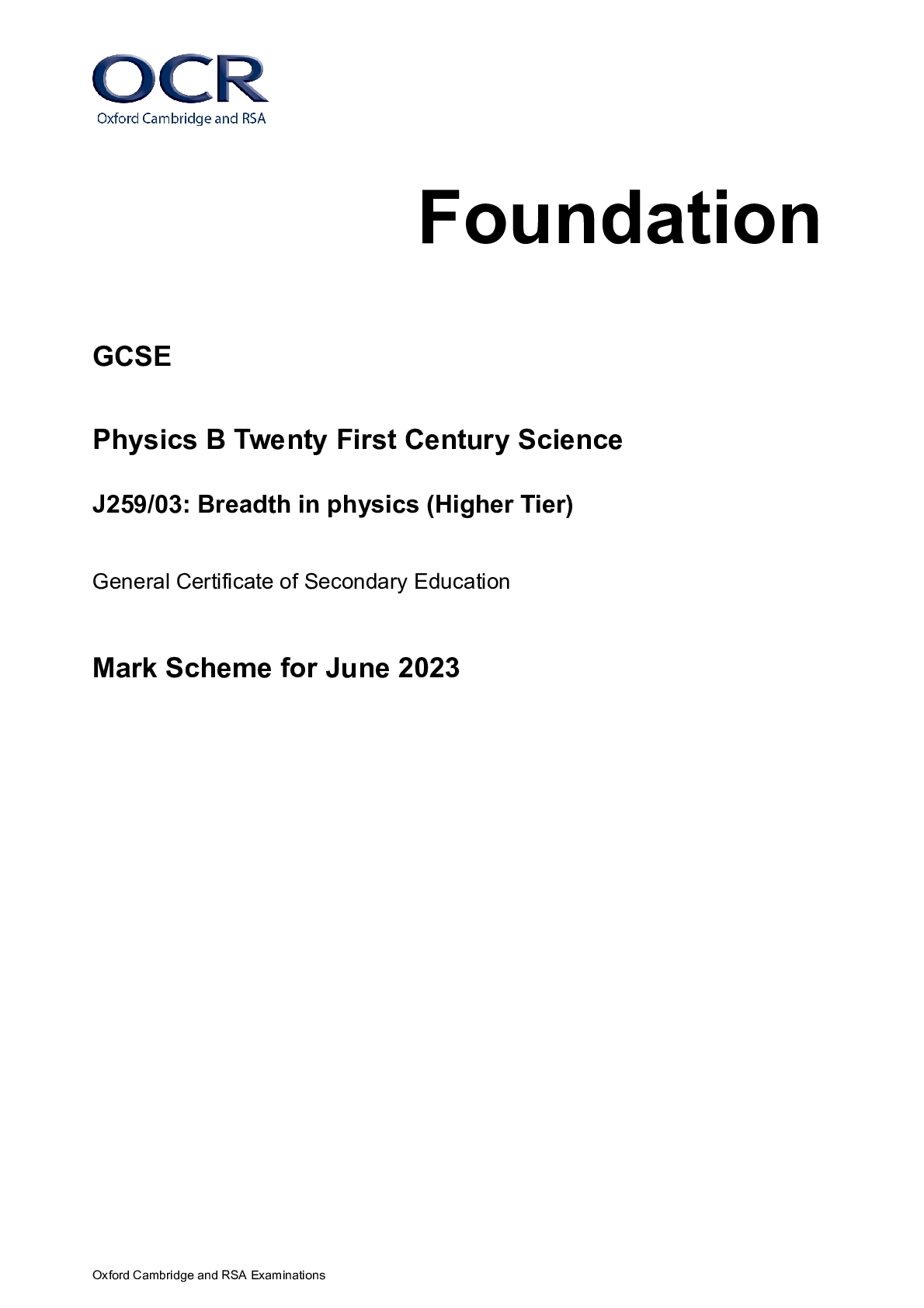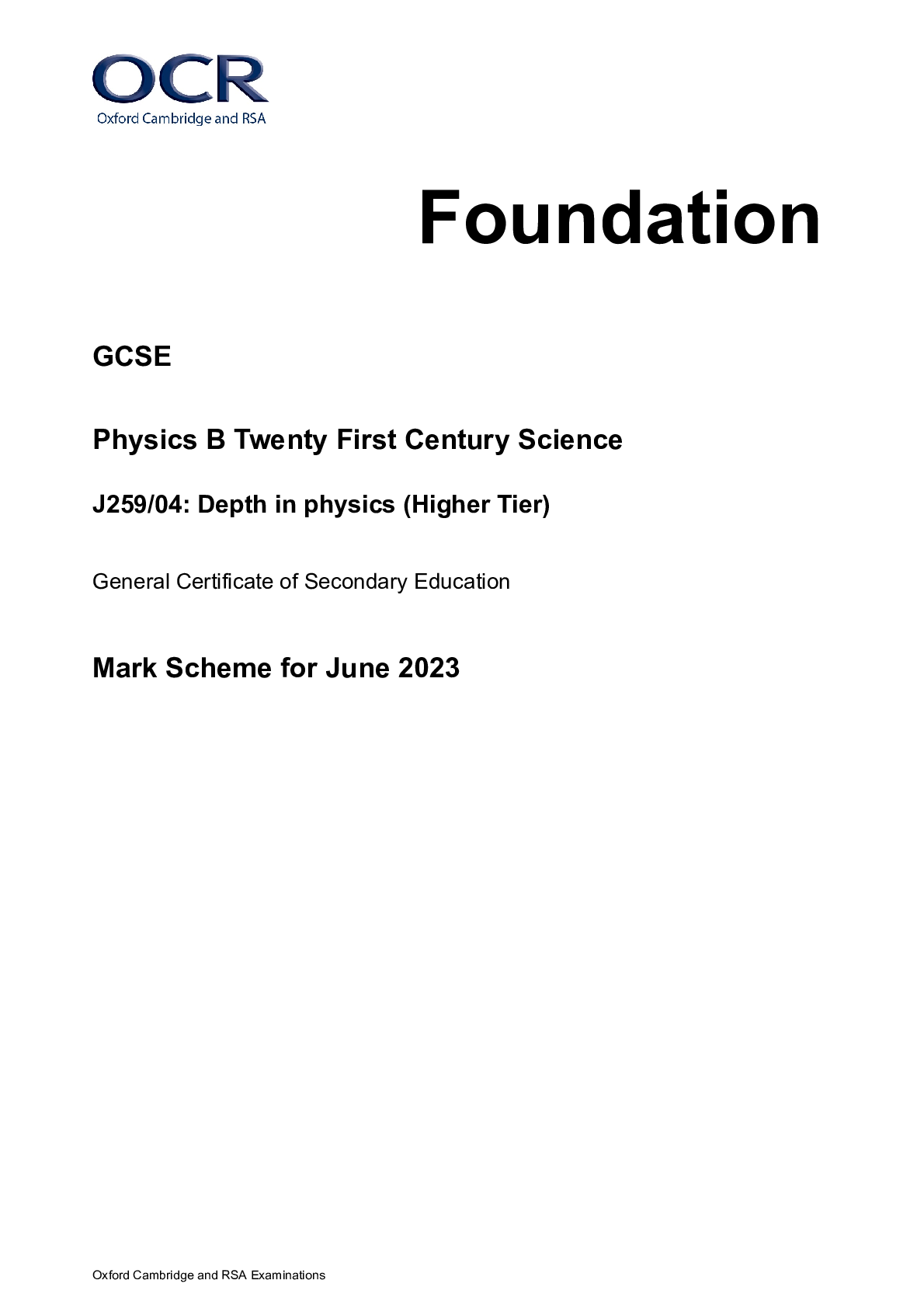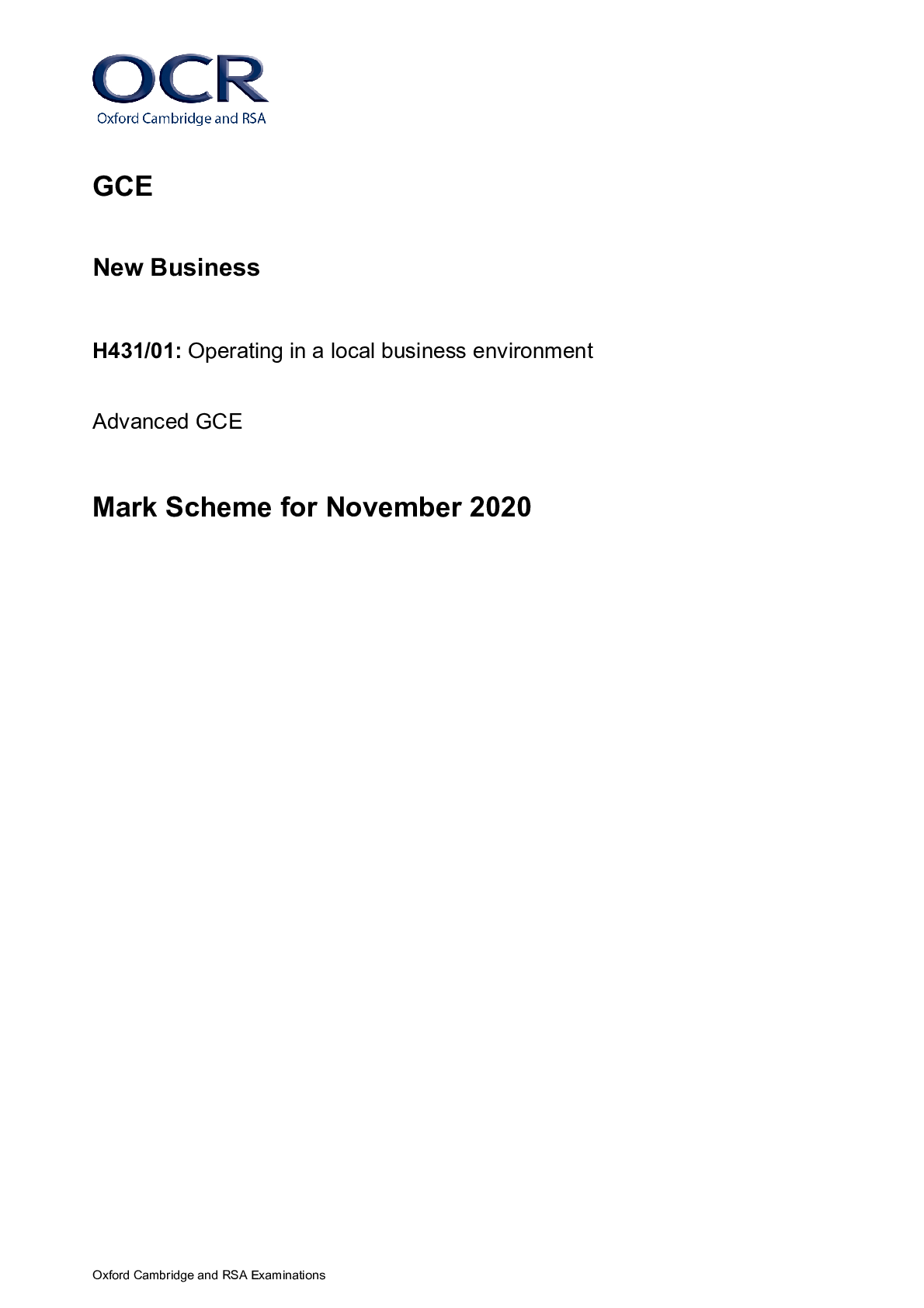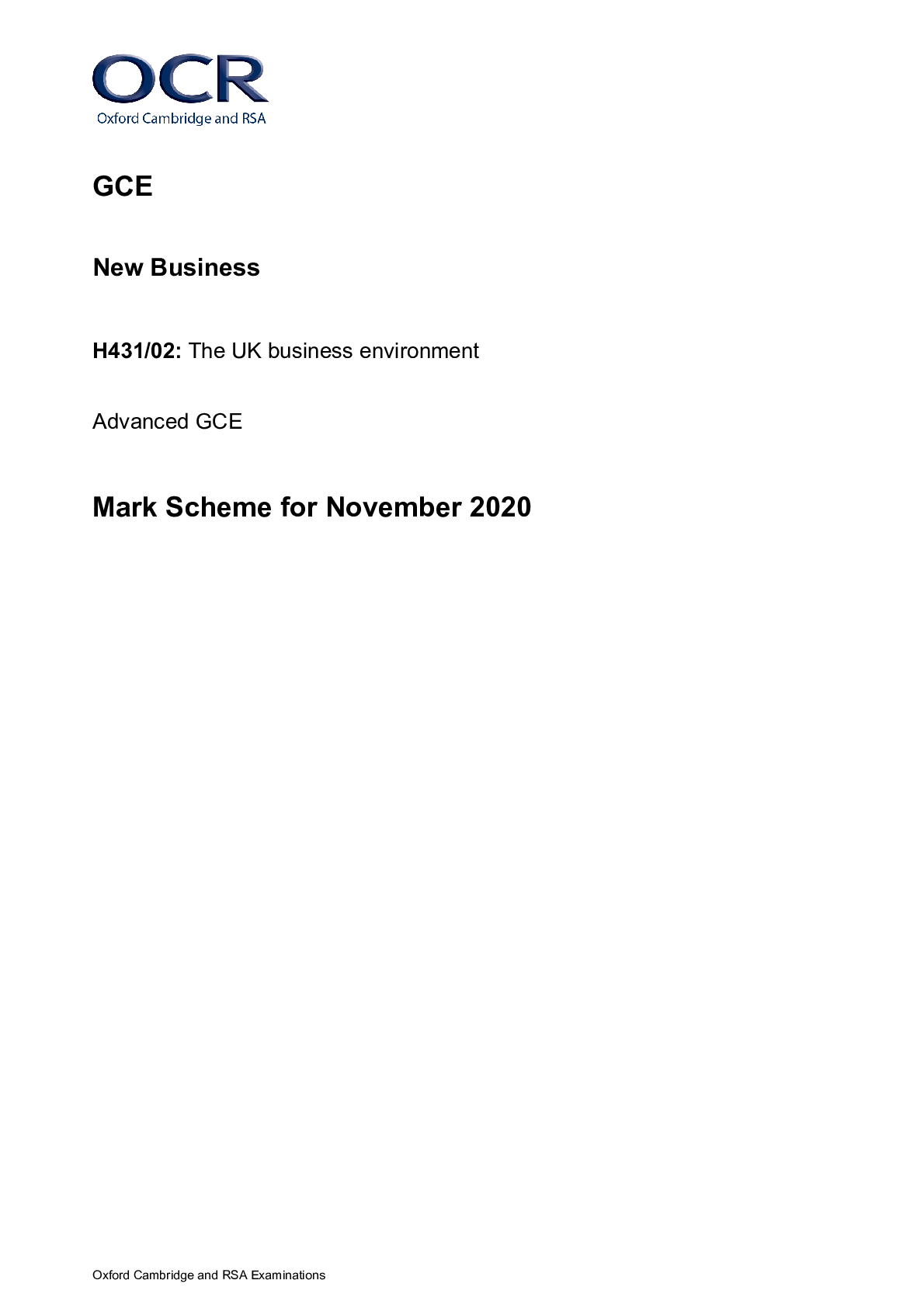English > MARK SCHEME > OCR ENGLISH PAPERS MARKING SCHEMES. Practice paper – Set 1 A Level English Language H470/01 Explor (All)
OCR ENGLISH PAPERS MARKING SCHEMES. Practice paper – Set 1 A Level English Language H470/01 Exploring language. FOUR MARKING SCHEMES
Document Content and Description Below
Question Guidance Marks Text features 1 Text A is a humorous piece from the magazine section of the Saturday edition of The Guardian newspaper, in which the writer Catherine Bennett pretends to be... a so-called ‘empty nester’, a mother whose children have just left home. It seems like the speaker is talking to a friend in a similar position. The article was published in August 2015. Giving careful consideration to the context of the text: (a) identify and analyse patterns of lexical and semantic use. (b) identify and analyse the way sentences are constructed. Possibilities are provided below for guidance but any valid response should be rewarded. General contextual points (AO3): Context can be understood in different ways. In this text there is the context of the text’s genre: a piece of satirical writing (part of a series) in a broadsheet newspaper. These kinds of pieces appear in the quality press and in Private Eye, where a ‘type’, usually particularly self-assured and/or in a high status position in society, is mocked through exaggeration. These pieces will develop in some way and become increasingly absurd as they go on. This one has a twist at the end where we realise that the ‘empty-nester’ is actually glad to 20 In each of the bullet points below, AO1 is covered at the start of the point and AO3 at the end. (a) identify and analyse patterns of lexical and semantic use Possible features could be: • use of proper nouns, reflecting the fact that the text relates to travel: ‘Syria’, ‘St Andrews’, ‘Toronto’ • temporal references/markers: ‘never’, ‘more time’, ‘every time’, ‘September’, ‘Christmas’ • a mix of low (‘Mandarin’) and high frequency (‘flat’) lexis, reflecting broadsheet context • lexical field of education: ‘tutors’, ‘essays’, ‘personal statements’ • use of foreign lexis ‘en suite’ – not italicised, as audience familiarity would be assumed • colloquial lexis used to create an informal register ‘kids’, and neologism ‘cuddlies’ • satirical effect comes from repetition of hyperbolic lexis ‘bereavement’ and ‘howling’ • shift from speaker’s smugness to selfishness, established semantically through movement from ‘sitting on her bed and howling’ to ‘off to the dump’ – use of bathos – means that discourse structure of text helps with pragmatic effect, with the ‘twist’ saved for the last paragraph • the semantics of the early part convey to the reader a critique of the smugness of the speaker with phrases like ‘joint history of art and Mandarin’ and the idea that 9 have the house free at last. It is designed to entertain but can also have a persuasive slant, prompting the reader to be critical of the subject. In terms of the social, cultural and historical context that surrounds the text, the speaker is clearly middle class and affluent (‘little place in France’) and the implied reader, who may recognise something of themselves in the character, should find their voice entertaining and irritating at the same time. This piece of written satire fits within the wider genre of satirical work, including TV and radio impression shows and the work of comedians and actors like Sacha Baron Cohen and Catherine Tate. It follows discourse structure of a one-sided conversation (e.g. the question at the start suggests they are already talking ‘That’s your last one off in September?’ and ‘I know, thanks’ implies that the speaker is replying to a suggestion from her friend). The reader, meanwhile, probably just sees the speaker as self-centred and dominant. The text is ironic: Catherine Bennett is taking on this voice to make fun of it. The character is meant to irritate the reader with comments like the last line ‘Do you want to see a picture of the puppy?’ which suggests that she has been pretty quick to replace her daughter. the implied listener in the text would automatically know that ‘St Andrews’ was a university, not just a town – links to context • shared knowledge expected here from the actual reader, who being part of the audience for a broadsheet, would know many of the references (b) identify and analyse the way sentences are constructed Possible aspects could be: • verb mood: uses of interrogative, sometimes to imply that this is a conversation, albeit one-sided, and sometimes rhetorical (‘They never stop being your baby, do they?’) – all designed to present character as selfcentred and ripe for mockery • Questions come in succession, in the tradition of quaestitio in rhetorical speech – bombarding the internal audience but also, obviously, the reader, making the character all the more irritating (e.g. end of first paragraph, three in a row) • minor sentences keep conversational feel (e.g. ‘Me, too, St Andrews’ ‘But young people can be so selfish, can’t they?’) – helps give authenticity to the speech and enforces satire, since reader often wants to reply ‘no’ to what she says (e.g. showing the puppy at the end, perhaps). ‘Me, too, St Andrews’ is superficially just chatty, but probably meant to exhibit trait of speaker to show off what her daughter is doing • Uses of tag questions (e.g. ‘can’t they’, ‘do they’), seen by Lakoff and others as female trait, designed often to engage other speakers. Here, again, probably meant to show a rather shallow element to the speaker, who 10 really just wants to talk • Use of multi-clausal compound-complex clauses such as ‘There’s Skype, of course… to ‘Toronto’ give sense of speaker rushing to get all the information out. Final clause from ‘even if…’ demonstrates how smug she is about her daughter’s achievements: it’s supposedly just incidental information at the end of the sentence, but actually packed full of ostentatious elements (e.g. phrase ‘a year in Toronto’) 11 There are a total of 20 marks available for Question 1. 10 marks can be awarded for part (a) and 10 marks for part (b). There is one mark per level for each AO. This table should be used twice – firstly to mark part (a) and allocate a mark out of 10, and then again to mark part (b) and allocate a mark out of 10. Parts (a) and (b) focus on different language levels, and therefore each part could achieve different levels. Each part should be marked completely separately – there is no need to look for consistency in allocating marks if the responses demonstrate different levels of competency. Level AO1 and AO3 Mark 5 • Candidates clearly identify patterns of language use in precise relation to the linguistic level specified in the task and can closely analyse incisively chosen evidence, with application of appropriate terminology; the writing is in a secure academic register. (AO1) • With a precise hold on the language feature specified in the task, candidates perceptively evaluate the possible effect of contextual factors on the way language is produced in this text and is received and understood by its audience. (AO3) 9–10 4 • Candidates can single out and analyse relevant examples of language use related to the linguistic level specified in the task, with application of appropriate terminology and coherent written expression. (AO1) • Focusing on the language feature specified in the task, candidates can convincingly weigh up some possible effects of contextual factors on the way language is produced in this text and the way it is received and understood by its audience. (AO3) 7–8 3 • Candidates make some clear points about language use which relate to the specified language level and are supported with relevant evidence; use of terminology is mostly appropriate, although likely to be less densely packed than the level above and written expression is clear but likely not to be economical. (AO1) • Having a reasonable sense of the language feature specified, candidates come to some clear conclusions about the possible effect of contextual factors on the way language is produced in this text and is received by its audience. (AO3) 5–6 2 • Candidates attempt to make their writing relevant to the feature and language level specified in the task, pulling out the occasional piece of evidence and using terminology which is partially appropriate; written expression has some errors but the meaning is nonetheless apparent. (AO1) • Having some sense of the language feature specified, candidates come to some fairly loose conclusions about the possible effect of contextual factors on the way language is produced in this text and is received by its audience. (AO3) 3–4 1 • Candidates make some link to the specified feature and language level and some terms are used, appropriately; evidence, if there, is likely to be barely relevant or only loosely defined (not actually quoted, for example) and writing may at times obscure meaning. (AO1) • Conclusions about the possible effect of contextual factors on the way language is produced and is received by the audience will be somewhat indistinct. There may be a vague sense of the text’s purpose. (AO3) 1–2 0 • No response or no response worthy of any credit. 0 12 Indicative Content - Please note: indicative content indicates possible points candidates might make, but this is not an exhaustive account. Any valid response should be rewarded. Question Guidance Marks Text features 2 ‘When we use language, we are mostly just copying other people.’ Write a blog post for an online news service (e.g. Buzzfeed or a newspaper or magazine) or for a personal website (e.g. one belonging to a writer or comedian like Caitlin Moran or Stephen Fry). You can explore the idea of imitation from any angle which you think is linguistically interesting and which will engage a reasonably well educated non-specialist audience. It should be no more than 500 words long. Possibilities are provided below for guidance but any valid response should be rewarded. AO5 Blogs are more interactive than articles in a newspaper or magazine and candidates should be rewarded for having that element in their writing. However, since a blog is an extended piece of writing, it is also important that the piece has some kind of shape to it, or it will not be rewarded as ‘expertly constructed’. A good model is the kind of piece found in the features or arts section of papers like The Times or The Guardian. These are sometimes also printed in the paper itself, but online they will be followed by a comment section, where readers can contribute to 24 AO2 The task can be approached in many ways (see options below), although to pull off a position which simply agrees with the statement in the task is not likely to be engaging critically with the concept of imitation wherever it occurs in language use. In terms of approach, the stimulus lends itself to a number of areas of language where the writer can critically engage with language whilst also entertaining her or his reader. In Child Language Acquisition, of course, whether children copy adults is still a theoretical debate. Candidates could start with the typical assumptions of a general reader that we learn language exclusively by copying our parents and carers (considering accents and dialects, for instance). The piece could then ‘turn’, looking at virtuous errors and the way children will not be corrected (‘swimmed’ etc) and then turn the debate around. Another direction to take the piece could be the notion of accommodation in spoken discourse, where candidates can show off what they know about varieties of English and overt/covert prestige. It should be possible to bring in the occasional study (Jenny Cheshire, for example). Likewise, the stimulus invites candidates to write about gender. There are some recent findings by Deborah Cameron, for example, that suggest that women are the early adopters of certain linguistic traits (the upward inflection, for instance) and that men are likely to take that trait on. These are just a few of a myriad of options. Just as feasible would be: do we copy each other in our uses of technology? How do new words get spread? Why do words spread and then disappear? 13 the debate. Many writers in these papers have blogs of their own and some public figures in the entertainment world and the world of education blog on a regular basis. Blog posts are usually light in tone. Some journalists maintain (e.g. the writer and editor of The Spectator’s ‘Coffee House’ blog, Isabelle Hardman) that blogs expect more specialist knowledge of their readers than a regular paper and, whilst there must be some manipulation of linguistic concepts to take account of a more general audience, it should be acceptable to have a sense that the readers are loyal and often expect this kind of blog post. To demonstrate flair, there will almost certainly need to be some kind of hook at the start. Online readers would turn away from dry lectures on language. One way to achieve this is through an anecdote of some kind, possibly personal, or possibly drawn from the news itself. A quotation or a lively piece of data might work too. Candidates will want to leave the reader on a strong final note, too. As always with this kind of writing, students can opt for irony, either partly or completely. They could take inspiration from Question 1 (‘The empty nester’ text) and take on the voice of someone who sees themselves as highly original in their use of language but actually is studiously copying the sociolect of their peers. The tough part of this would be to manage to ‘critically engage’ with the language issue at the same time. No doubt possible through satire, but difficult. Below are some areas that could be covered: • Accommodation: how we copy accent and dialect, but also sometimes deliberately diverge • Overt and covert prestige: how we follow others in prestige forms, perhaps to gain power. More likely among females, perhaps (see Trudgill) • Behaviourism vs nativism in the acquisition of speech. Are we parrots or natural geniuses with language? • Technology – how traits spread across social media, texting, Twitter, including neologisms, emoticons, expressive punctuation and so on. Some complex studies in this area – very hard to pin down exactly how and why language changes… • Representation: the notion of the online persona – do we copy others? Again, to show assured knowledge and understanding, depth in particular areas – an editorial just focusing on examples of copied or created speech by children, for example – could be more effective than ranging widely across a number of areas of language. Probably only one of the above can be handled well in the time – but prepare to be surprised! Indeed, the sense of the piece building to a definite finish is a mark of a candidate being in control of their material. Of course this task is actually a form of 14 transformation for candidates, where they are taking what they have learnt about the specified concept and re-presenting it for a non-specialist audience. The topic would require some high level thinking, but a wide range of formality levels could be justified, depending on the kind of publication, as long as it is kept consistent through the text. Some challenging vocabulary might make it in, but any jargon such as ‘language acquisition device’ or ‘neologism’, while appropriate for the study of is going to be less welcome in a blog like this. The piece is likely to have more colloquial touches than a print article, including uses of idiom and contractions (‘don’t’, etc.) and minor sentences used deliberately (easy to spot this kind of purposeful rule-breaking if the rest of the article uses accurate standard punctuation!) but will not be too chatty. Synthesising AO2 and AO5 It is important that candidates do not simply ‘rant’. All good discursive or argumentative writing has to be supported with evidence and this evidence must be engaged with, critically, for high marks. Candidates will need to have learnt some facts, some quotes, some names and statistics to prepare for this exam and have a few personal anecdotes up their sleeve. This will be a place to show their knowledge and to put any wider reading about English Language to good use. 15 There are a total of 24 marks available for Question 2. Decide on a mark for AO2 out of 12, and then a separate mark for AO5 out of 12. Add the two marks together to reach a total out of 24 marks. It is possible that candidates may achieve different levels for each AO: allocate the mark according to the level of competency demonstrated for each AO individually. Level AO2 Mark AO5 Mark 6 • In their piece of writing, candidates show an assured knowledge and understanding of the specified concept and issue and its relevance to language use. • Candidates engage critically with the specified concept and issue. 11–12 • An expertly-constructed text showing, perhaps surprising, originality in making the piece appropriate to the form specified in the task. • The use of appropriately chosen linguistic features shows flair and the writing precisely suits the audience defined in the task. 11–12 5 • In their piece of writing, candidates show a good knowledge and understanding of the specified concept and issue and its relevance to language use. • In their piece, candidates show that they can take a critical angle on the specified concept and issue. 9–10 • A well-constructed text, which is appropriate to the form specified in the task. • The use of appropriately chosen linguistic features shows skill and their writing suits the audience defined in the task. 9–10 4 • In their piece of writing, candidates show an essentially sound level of knowledge and understanding of the specified concept and issue and its relevance to language use. • Candidates show that they have some ability to think and write critically about the concept/issue. 7–8 • A deliberately constructed text, which contains most of the main elements of the form specified in the task. • There is clear use of appropriate linguistic features and the writing has been modulated to take account of the audience defined in the task. 7–8 3 • Their knowledge and understanding of the chosen language concept or issue is mostly accurate, although is likely to lack the depth needed to be convincing. • In their piece of writing, candidates have addressed the specified language concept/issue, although not critically. 5–6 • A text which is attempting to match the task’s purpose and which is at least recognisable as an example of the form specified in the task. • There are some appropriate language features employed and some attempts have been made to take account of the audience defined in the task. 5–6 2 • Candidates’ knowledge and understanding of the concept/issue is likely to have inaccuracies or be muddled. • The language concept/issue is present in the piece although somewhat indistinct or confused. 3–4 • A text which has some sense of the form specified in the task, but which leaves out key elements. • There are some attempts to use appropriate language features, although probably not employing a register which suits the audience defined in the task. 3–4 16 Level AO2 Mark AO5 Mark 1 • Candidates do not appear to understand the concept or issue but it is possible to see one or two points relating to it. • The language concept or issue will be just barely detectable in the piece. 1–2 • Candidates produce writing which has little sense of the specified task, although there may be one or two superficial features of the form specified in the task. • One or two appropriate language features may be present; the audience is not understood or addressed. 1–2 0 • No response or no response worthy of any credit. 0 • No response or no response worthy of any credit. 0 17 Indicative Content - Please note: indicative content indicates possible points candidates might make, but this is not an exhaustive account. Any valid response should be rewarded. Question Guidance Mark Text features 3 Text B is an edited extract from a conversation from The Listening Project, broadcast on Radio Four in February 2016. Two serving police officers, Iain and Claire, talk about life in the police force Text C is a thread from an online forum for people working in the police force and those interested in police work. The posts have been edited. Using appropriate linguistic concepts and methods, analyse the ways in which language is used in these two texts. In your answer you should: • explore connections and variations between the texts • consider how contextual factors contribute to the construction of meaning. A03 A subtle but distinctive contrast between what appears to be a genuinely spontaneous conversation in Text B (albeit delivered often in quite a careful and professional way) and an online Forum which contains features of 36 Phonetics, phonology and prosodics Text B Text C • Elision of words (e.g. ‘kinda’, ‘gonna’) from both speakers suggests both speed of conversation and informality of situation • Emphatic stress (‘any day of the week’) suggests their animation and passion for their work. • Standard English with no attempt at phonetic spellings • Expressive punctuation and use of capitals – e.g. ‘NOT WHAT IT USED TO BE’ mimics increased volume in speech, to suggest strength of writer’s cynicism about modern policing. Lexis and semantics Text B Text C • A small amount of low frequency Latinate lexis: ‘serving the community’ is a collocation belonging to the field of policing, suggesting pride in the role • Lexis from field of policing, including the term ‘thieves on’, shows shared knowledge of two speakers and, at that point, minimal thought for an ultimate radio audience • Iain and Claire seem to become more formal and drop their non-standard usage when they come to the final sequence containing advice about policing to notional new recruits. • Mixed register in terms of vocabulary, with some more low frequency Latinate lexis than Text B: e.g. ‘recruits’, ‘dispute’, impartial’, ‘negativity’, suggesting that writers, in this public space wish to represent themselves professionally. Suggests overt prestige • Field-specific lexis peppers the forum posts, with uses of noun phrases like the somewhat euphemistic ‘verbal domestic disputes’, showing professionalism of contributors. Not overwhelmingly specialised, however, as the originator of the thread, jamie678, is not a serving police officer • Interesting example of prescriptivist attitude in the post ‘defiantly or 18 conversational discourse but, as Crystal has suggested, arguably following a mode belonging particularly to language and technology. Text B follows a turntaking structure, with plenty of overlapping and interruption. In Text C turns, or posts, are more extended and use a range of interesting multimodal elements (including their own ‘handles’, emoticons and expressive punctuation). The audience for the Text B programme, being on Radio Four, is reasonably educated, but the conversation (whilst edited down) is not mediated at this point (The Listening Project does have an introduction from journalist Fi Glover, not included here) – hence it is fairly freeflowing and anecdotal. In Text C, the audience is police-oriented, so there is some use of a more specialised register. The posts are in approachable language with spoken mode elements (e.g. minor sentences like ‘Possibly not’). The discourse is asynchronous, with time delays of up to a few hours, meaning that each post tends to be quite crafted. • Interesting use of neologism/compound noun ‘cybercrime’ and the wellknown compounded brand name ‘Facebook’ - suggests interest in this newer field of policing and Claire’s own regard for the idea of moving forward. definitely?’ again showing contributors’ and/or moderators’ desire to maintain standards of expression on this forum, not typical of all online communication • Figurative language includes common idioms (e.g. ‘welcome aboard’, ‘air any concerns’), showing that this forum is based around the concept of spoken discourse • Swear word used by Zulu 22, is actually a quote from a possibly made-up officer, said to him/her when joining up. It is also asterisked to avoid offence, showing a distance from the use of this lexis in this context, again reinforcing the values of the Forum • Language of ‘Forum’, itself a word which has undergone semantic change from its classical origins, such as ‘Posted’ and the phrase ‘Forum Member’ all notable and part of this form of communication. Pragmatics Text B Text C 19 • No use of irony, particularly. All pragmatics are on the surface of all utterances by both speakers. • The little sayings like ‘It’s going to be a two banana kind of day’ are not necessarily directly linked to the meaning of the post above them – seem to be part of a separate more long-term discourse, part, perhaps, of a kind of covert prestige element to the discourse. [Show More]
Last updated: 1 year ago
Preview 1 out of 97 pages
.png)
Reviews( 0 )
Document information
Connected school, study & course
About the document
Uploaded On
Jul 10, 2022
Number of pages
97
Written in
Additional information
This document has been written for:
Uploaded
Jul 10, 2022
Downloads
0
Views
92

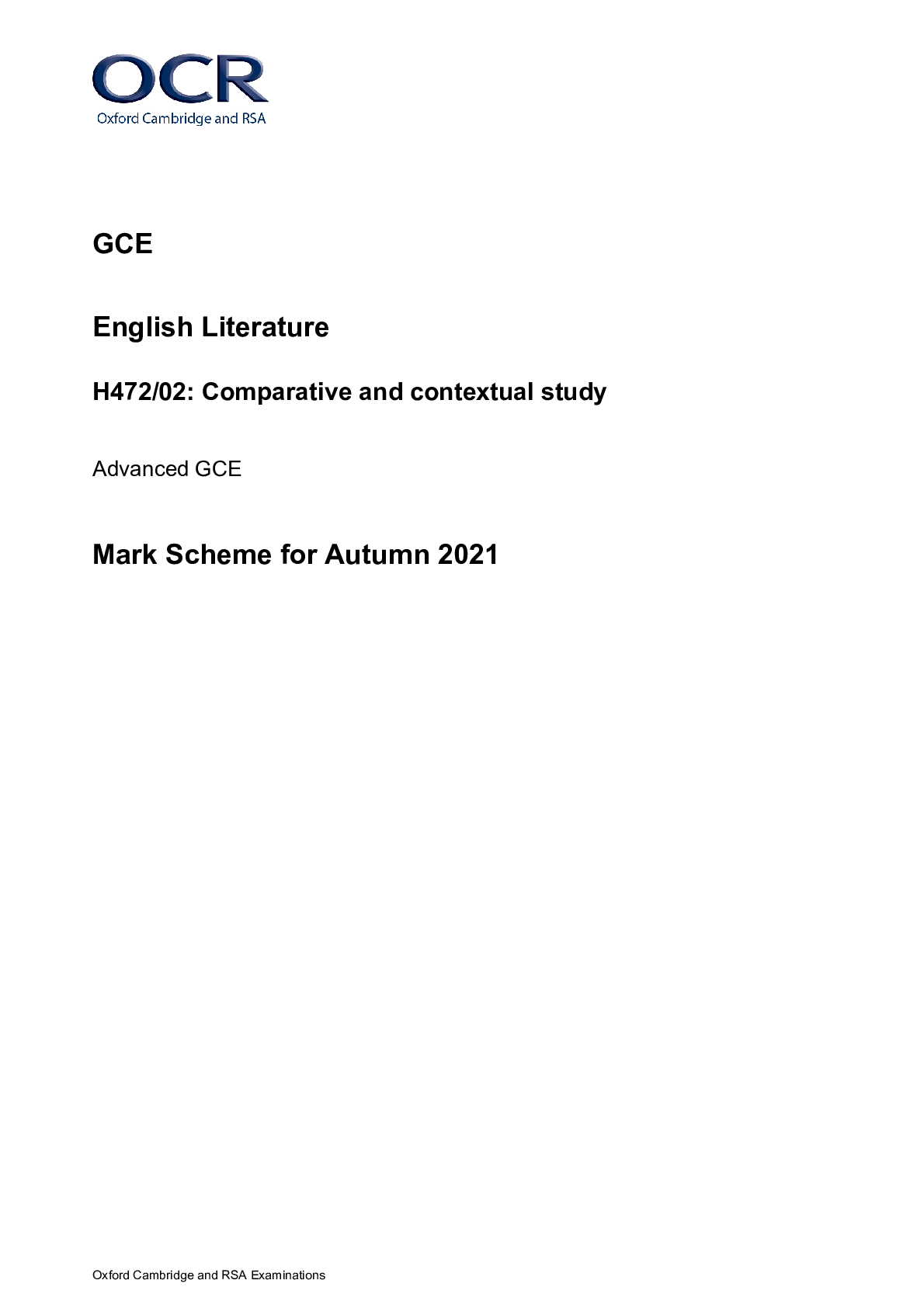
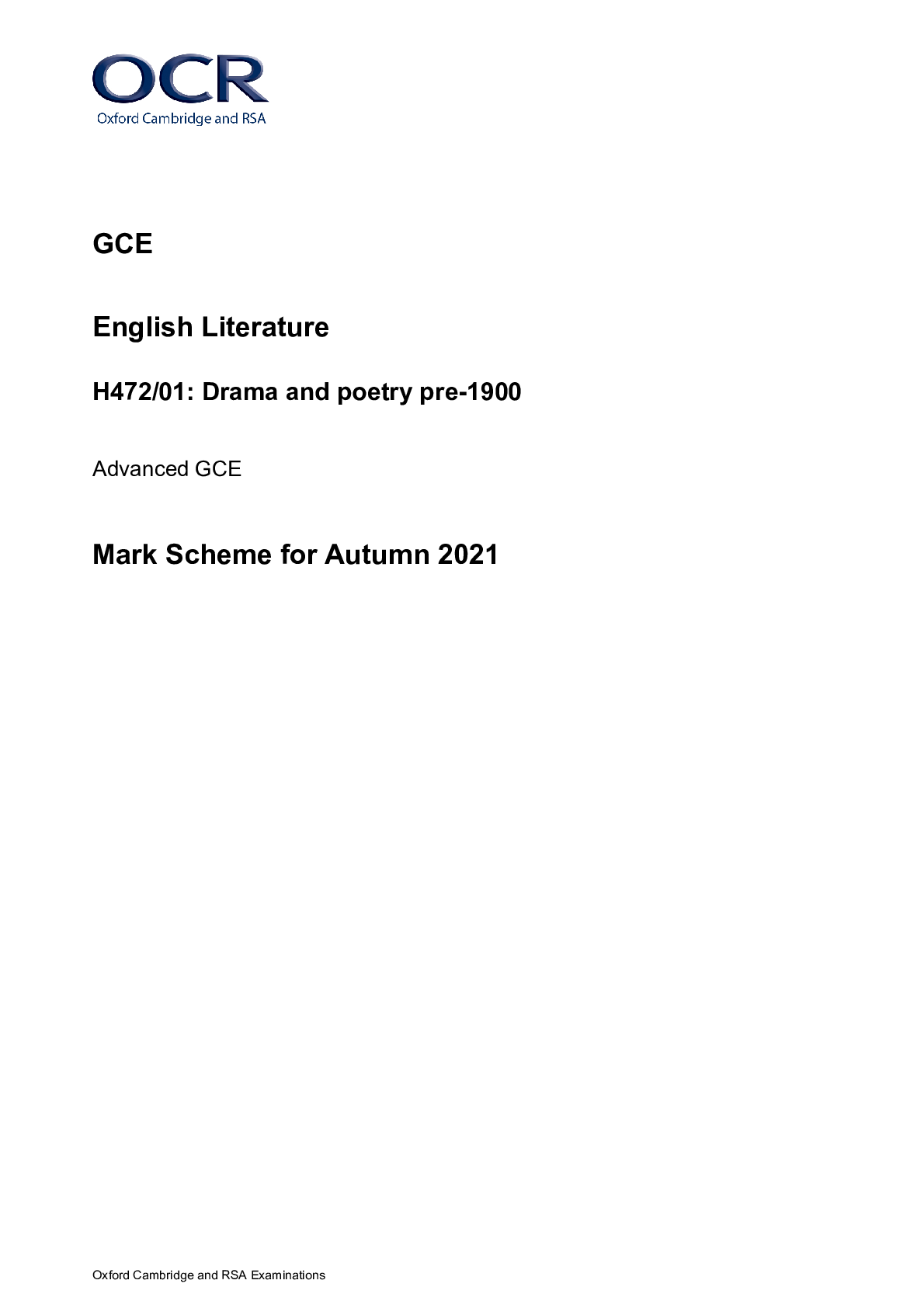
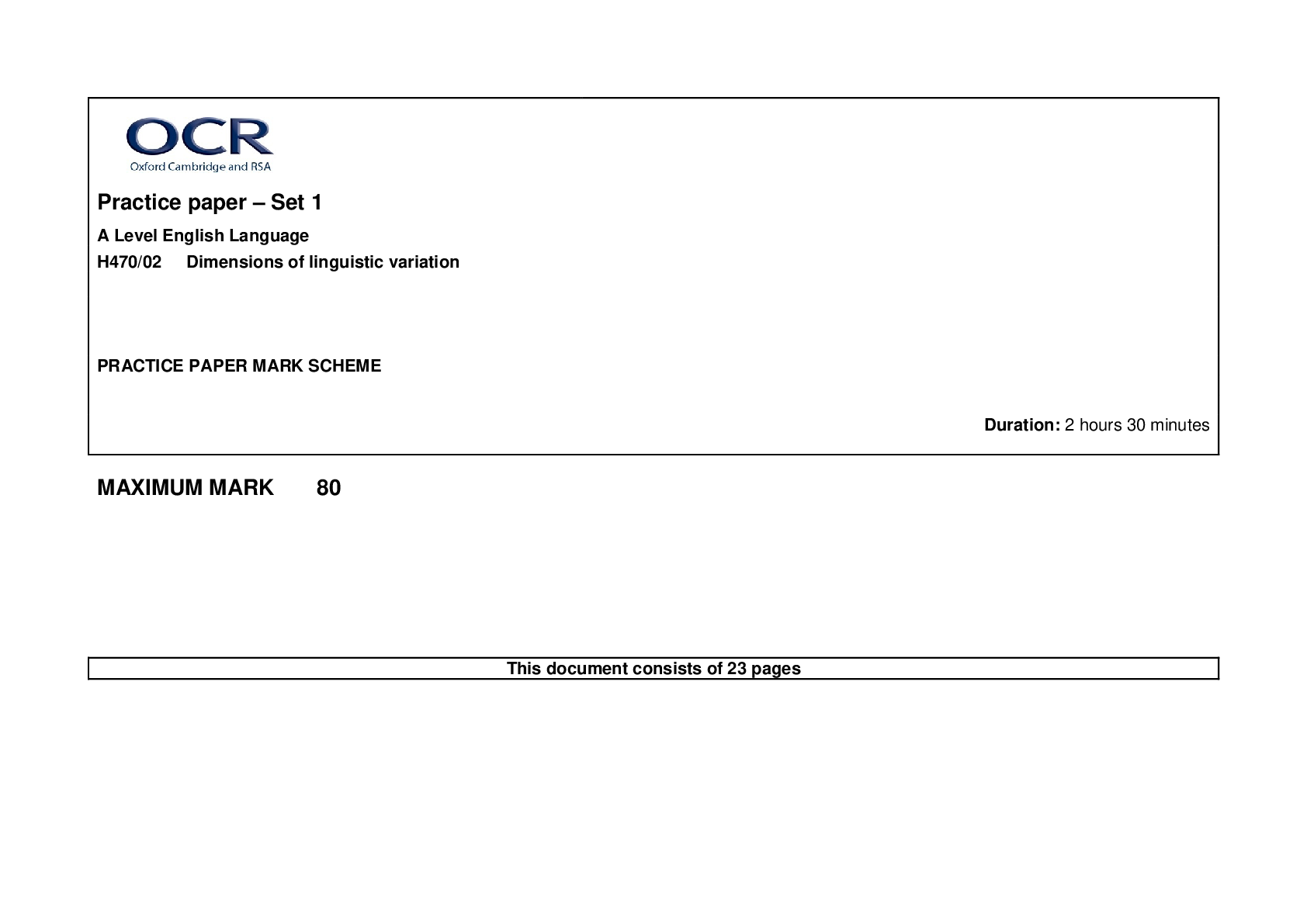

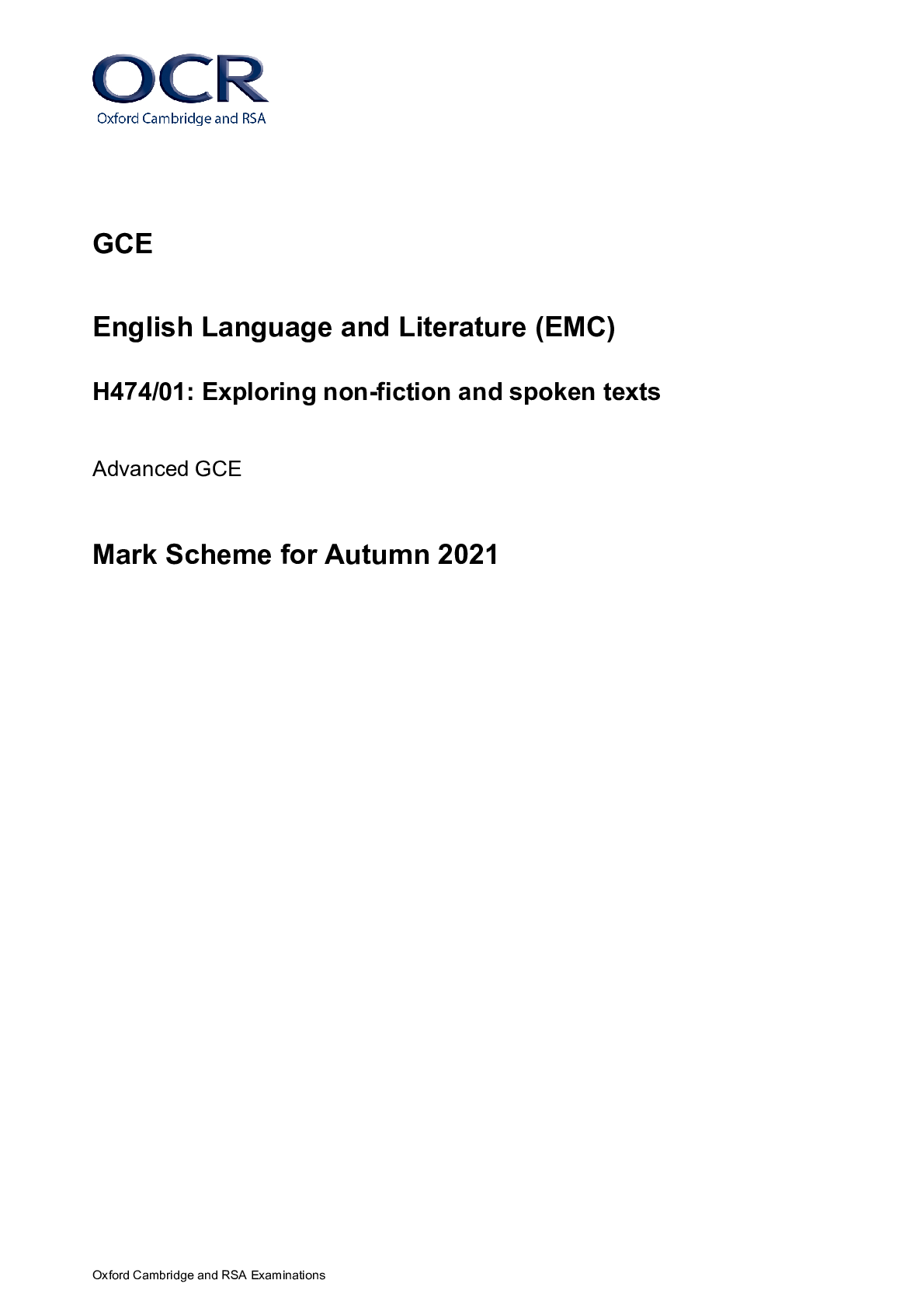



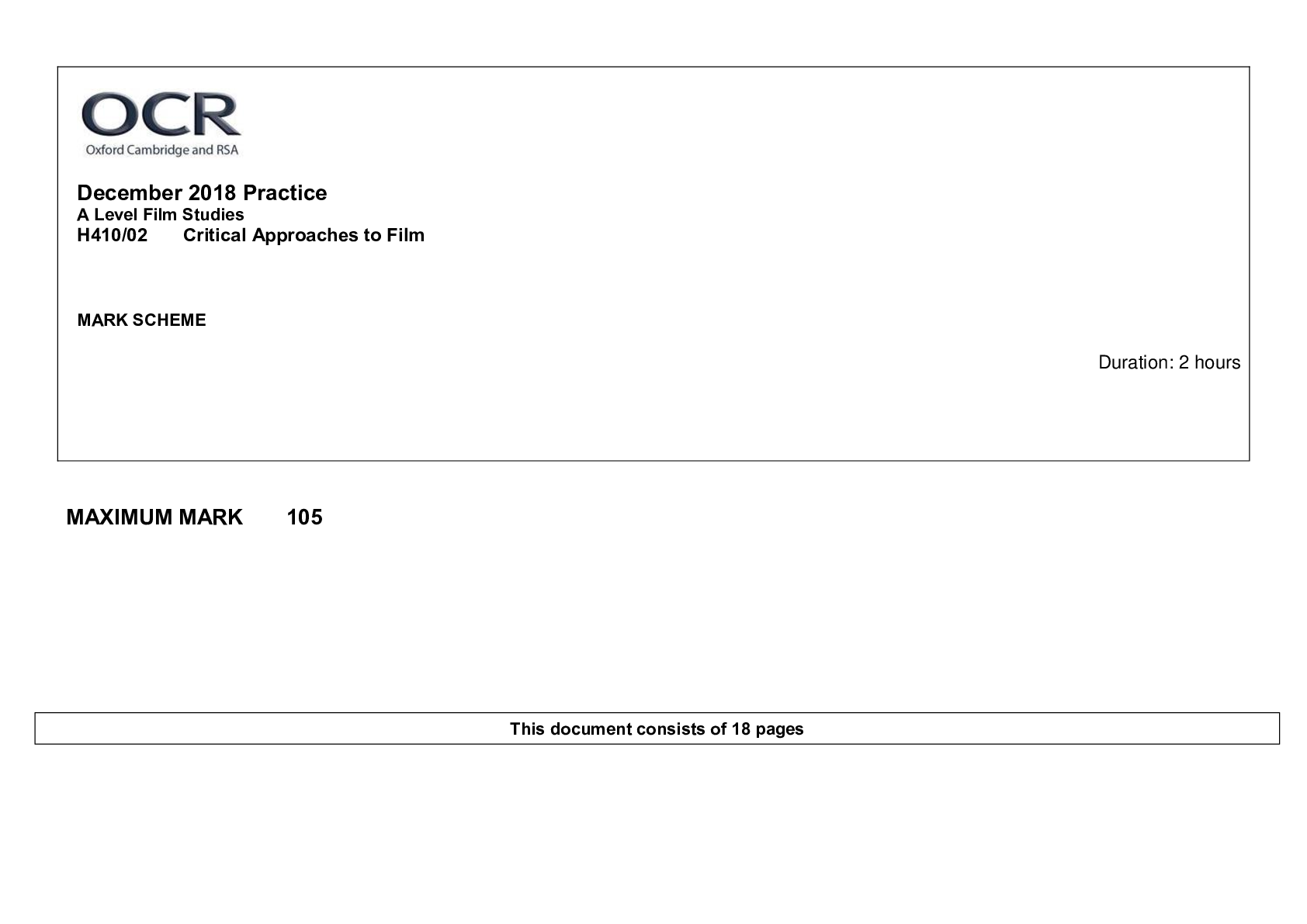

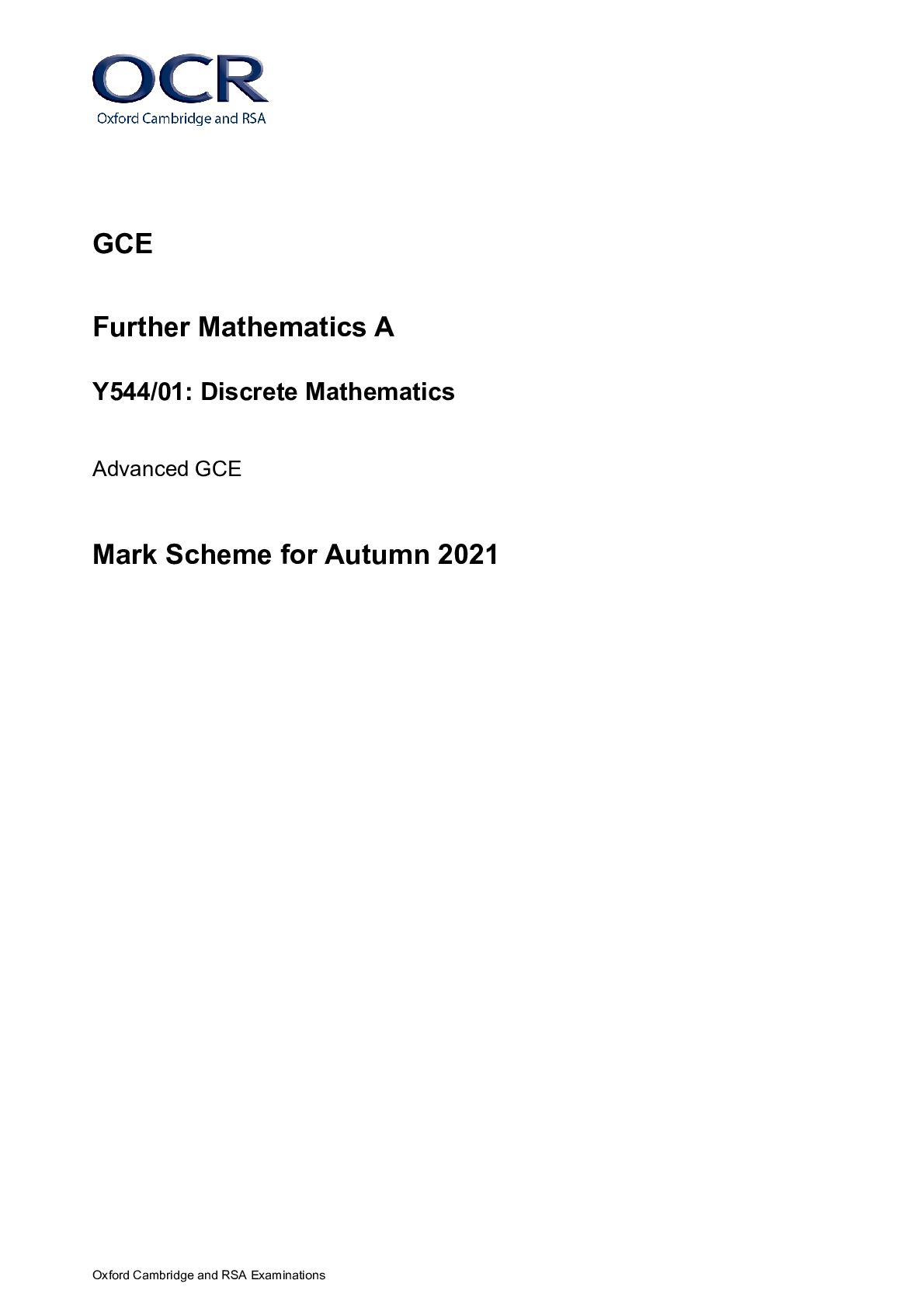
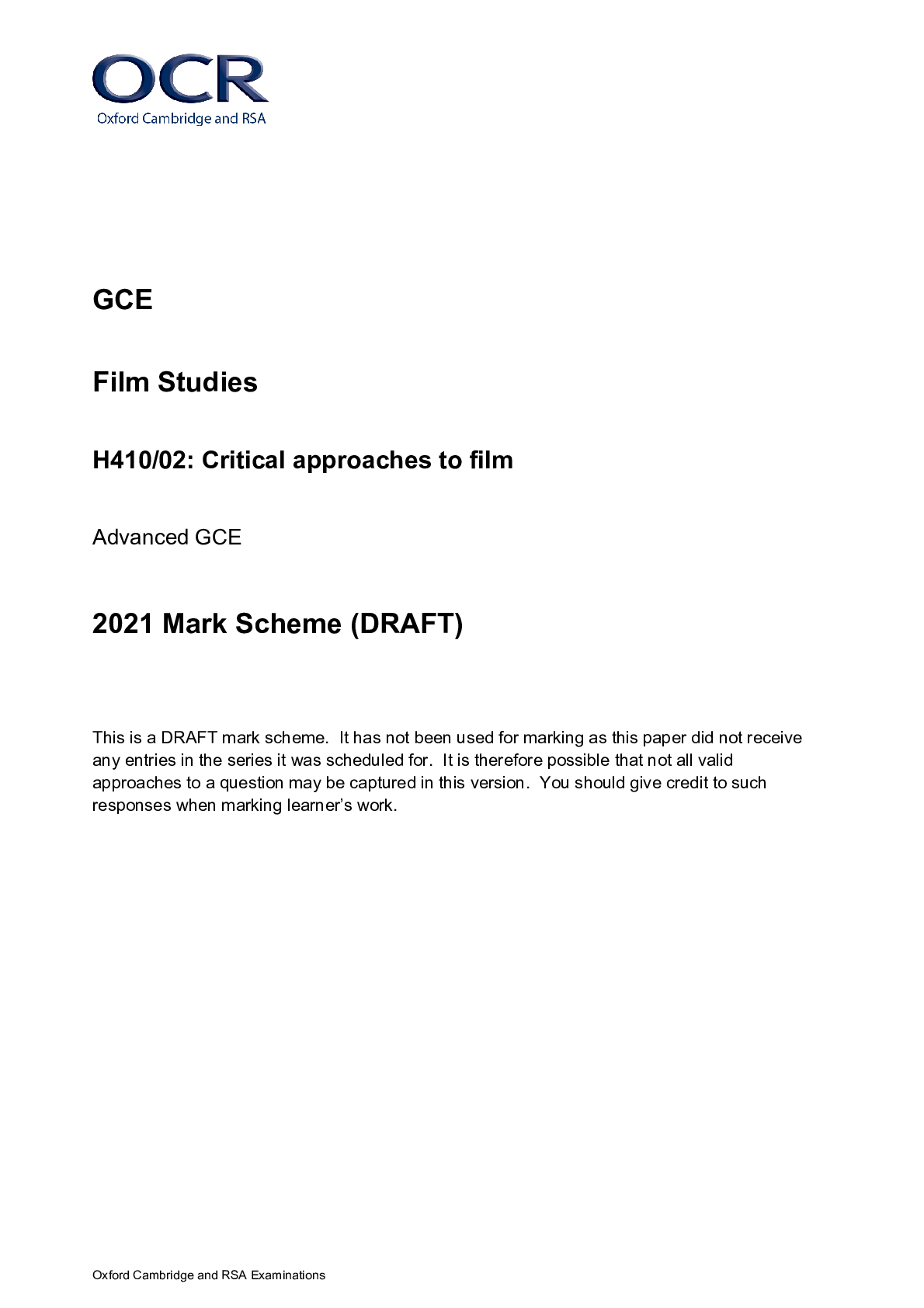

H63001Pure Mathematics and MechanicsMARK SCHEM.png)

